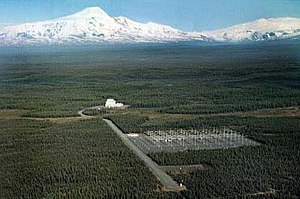HAARP
 |
|
| Established | 1993 |
|---|---|
|
Field of research
|
Ionosphere |
| Location | Gakona, Alaska, United States |
|
Operating agency
|
University of Alaska Fairbanks |
The High Frequency Active Auroral Research Program (HAARP) was an ionospheric research program jointly funded by the U.S. Air Force, the U.S. Navy, the University of Alaska, and the Defense Advanced Research Projects Agency (DARPA), designed and built by BAE Advanced Technologies (BAEAT).
Its purpose was to analyze the ionosphere and investigate the potential for developing ionospheric enhancement technology for radio communications and surveillance. The HAARP program operated a major sub-arctic facility, named the HAARP Research Station, on an Air Force-owned site near Gakona, Alaska.
The most prominent instrument at the HAARP Station is the Ionospheric Research Instrument (IRI), a high-power radio frequency transmitter facility operating in the high frequency (HF) band. The IRI is used to temporarily excite a limited area of the ionosphere. Other instruments, such as a VHF and a UHF radar, a fluxgate magnetometer, a digisonde (an ionospheric sounding device), and an induction magnetometer, were used to study the physical processes that occur in the excited region.
Work on the HAARP Station began in 1993. The current working IRI was completed in 2007, and its prime contractor was BAE Systems Advanced Technologies. As of 2008, HAARP had incurred around $250 million in tax-funded construction and operating costs. It was reported to be temporarily shut down in May 2013, awaiting a change of contractors. In May 2014, it was announced that the HAARP program would be permanently shut down later in the year. Ownership of the facility and its equipment was transferred to the University of Alaska Fairbanks in mid-August 2015.
...
Wikipedia
